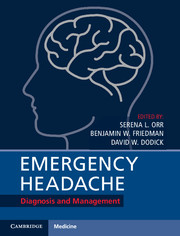Book contents
- Emergency Headache
- Emergency Headache
- Copyright page
- Contents
- Contributors
- Preface
- 1 Introduction
- 2 Epidemiology of Headache in the Emergency Department
- 3 Approach to History Taking and the Physical Examination
- 4 Approach to Investigations
- 5 Thunderclap Headache in the Emergency Department
- 6 Other Secondary Headaches in the Emergency Department
- 7 The Migraine Patient in the Emergency Department
- 8 The Patient with a Trigeminal Autonomic Cephalalgia in the Emergency Department
- 9 Other Primary Headache Disorders That Can Present to the Emergency Department
- 10 Medication Overuse Headache in the Emergency Department
- 11 Approach to the Pediatric Patient with Headache in the Emergency Department
- 12 Approach to Pregnant or Lactating Patients with Headache in the Emergency Department
- 13 Approach to the Elderly Patient with Headache in the Emergency Department
- 14 Preventing Emergency Department Visits in Primary Headache Patients and Prevention of Bounce-Backs to the Emergency Department
- Index
- References
4 - Approach to Investigations
Published online by Cambridge University Press: 09 October 2017
- Emergency Headache
- Emergency Headache
- Copyright page
- Contents
- Contributors
- Preface
- 1 Introduction
- 2 Epidemiology of Headache in the Emergency Department
- 3 Approach to History Taking and the Physical Examination
- 4 Approach to Investigations
- 5 Thunderclap Headache in the Emergency Department
- 6 Other Secondary Headaches in the Emergency Department
- 7 The Migraine Patient in the Emergency Department
- 8 The Patient with a Trigeminal Autonomic Cephalalgia in the Emergency Department
- 9 Other Primary Headache Disorders That Can Present to the Emergency Department
- 10 Medication Overuse Headache in the Emergency Department
- 11 Approach to the Pediatric Patient with Headache in the Emergency Department
- 12 Approach to Pregnant or Lactating Patients with Headache in the Emergency Department
- 13 Approach to the Elderly Patient with Headache in the Emergency Department
- 14 Preventing Emergency Department Visits in Primary Headache Patients and Prevention of Bounce-Backs to the Emergency Department
- Index
- References
Summary
A variety of testing modalities are available in the emergency department (ED) to enable diagnosis of headache. For an emergency care provider, the goal is to order those tests that will facilitate diagnosis in a timely manner, without burdening the patient and healthcare system with unnecessary tests, particularly those tests that are time-consuming, uncomfortable, or expensive. Available diagnostic tests include analyses of blood, urine, and cerebrospinal fluid (CSF), as well as a variety of neuroimaging modalities. In this chapter, we discuss the utility, indication, and best practice with regard to the many tests commonly available in an ED.
- Type
- Chapter
- Information
- Emergency HeadacheDiagnosis and Management, pp. 26 - 42Publisher: Cambridge University PressPrint publication year: 2017

